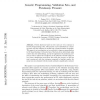75 search results - page 3 / 15 » On the Strength of Size Limits in Linear Genetic Programming |
ICMLA
2007
13 years 7 months ago
2007
Gene Expression Programming (GEP) is an evolutionary algorithm that incorporates both the idea of a simple, linear chromosome of fixed length used in Genetic Algorithms (GAs) and...
CEC
2005
IEEE
14 years 1 days ago
2005
IEEE
The most controversial part of genetic programming is its highly disruptive and potentially innovative subtree crossover operator. The clearest problem with the crossover operator...
EUROGP
2009
Springer
14 years 1 months ago
2009
Springer
Code bloat, the excessive increase of code size, is an important issue in Genetic Programming (GP). This paper proposes a theoretical analysis of code bloat in GP from the perspec...
SEAL
1998
Springer
13 years 10 months ago
1998
Springer
Genetic programming evolves Lisp-like programs rather than fixed size linear strings. This representational power combined with generality makes genetic programming an interesting ...
CORR
2006
Springer
13 years 6 months ago
2006
Springer
Fitness functions based on test cases are very common in Genetic Programming (GP). This process can be assimilated to a learning task, with the inference of models from a limited n...

